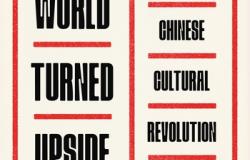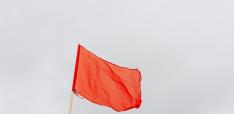Book Review: The World Turned Upside Down - Parts 1 and 2

"The World Turned Upside Down"—a critical review (Part 1)
This may be the most difficult book review to write. I have decided to break it into two parts. Writing it is difficult because one has to have huge admiration for Yang Jisheng, a former journalist, now a historian, who has amassed an incredible amount of information about the political maneuvering, personal relations, events and, most importantly, victims of the Cultural Revolution and presented all of this in his new book “The World Turned Upside Down: A History of the Cultural Revolution” (published in English only two months ago). Yang reminds me of those few courageous authors, indignant by the inequities of communism who, beginning with Djilas, then the Medvedev brothers and even Solzhenitsyn himself, or Volkogonov in his biographies of Lenin and Stalin, have written valuable testimonials about the system.
But, alas, most of them were almost fully ignorant of political science, economics and historiography. Yang is perhaps an extreme example: on the one hand, extraordinary evidence that he has collected (I think that the book must contain several thousand names of people involved), and on the other hand, equally extraordinary absence of any thinking about that evidence. The book is thus a succession of events, many of them tragic, conferences and rallies, gossip and innuendoes, intrigues and betrayals. Yang is the type of writer whom Cicero two thousand years ago dismissively called “narratores rerum”.
So, in my first review I will focus on these defects and problems.
 Yang’s explanation for many events during the Cultural Revolution, including ritualistic vows of fealty to Mao, is “totalitarianism”. It is repeated a number of times. It is a cool word to say, but the Cultural Revolution was anything but totalitarianism. It might have been started by Mao (although I will explain later that Yang never tells us why) but while totalitarianism is absence of agency by individuals, the Cultural Revolution was the opposite: millions of individuals had agency. They had too much of it. The Cultural Revolution was not totalitarianism, but its very reverse: Hobbesian world where everyone fought everyone else. The most tragic revelation about the Cultural Revolution (an observation that Yang does not make) is that it shows us what the withdrawal of the state and government does: it reveals human nature at its worst. Without state’s monopoly on violence, we would simply go out fighting each other. Forever. Imagine the United States, when suddenly the President, Congress, all politicians, judges, and police simply decide to go home and never return to their jobs. Within a week, the country would be in a “Cultural Revolution”. (Actually, with Katrina, it took less than a week for New Orleans to descend into the “Cultural Revolution”.) China during the Cultural Revolution was not Stalinism redux, but Libya today.
Yang’s explanation for many events during the Cultural Revolution, including ritualistic vows of fealty to Mao, is “totalitarianism”. It is repeated a number of times. It is a cool word to say, but the Cultural Revolution was anything but totalitarianism. It might have been started by Mao (although I will explain later that Yang never tells us why) but while totalitarianism is absence of agency by individuals, the Cultural Revolution was the opposite: millions of individuals had agency. They had too much of it. The Cultural Revolution was not totalitarianism, but its very reverse: Hobbesian world where everyone fought everyone else. The most tragic revelation about the Cultural Revolution (an observation that Yang does not make) is that it shows us what the withdrawal of the state and government does: it reveals human nature at its worst. Without state’s monopoly on violence, we would simply go out fighting each other. Forever. Imagine the United States, when suddenly the President, Congress, all politicians, judges, and police simply decide to go home and never return to their jobs. Within a week, the country would be in a “Cultural Revolution”. (Actually, with Katrina, it took less than a week for New Orleans to descend into the “Cultural Revolution”.) China during the Cultural Revolution was not Stalinism redux, but Libya today.
Under totalitarian regimes, every individual, spontaneous action is proscribed. Writing on your own a letter of support to Stalin was as likely to land you in jail as writing a letter criticizing Stalin. Not so under the chaos of the Cultural Revolutions: everyone wrote big-character posters, organized rallies, attacked “traitors”, called themselves a follower of “Mao Zedong’s line”. It is just that nobody knew what that line was today or what it might become tomorrow. Neither did Mao.
But if not totalitarianism, was it autocracy? That too is difficult to justify in standard terms. Mao did not rule like an autocrat; he ruled like a God; which meant that he appeared just from to time, when needed. Yang shows that Mao, uninterested in management of the country and the economy, and even in foreign affairs, simply delegated all of day-to-day running of the country to various people, mostly to Zhou Enlai. But even saying “delegated” is an exaggeration. Mao just ignored the running of the country, and whoever managed to get to it, did. If, in this management, “the delegate” did something that eventually displeased Mao, he could end up dismissed, expelled from the party, wearing a dunce hat, being driven to suicide or pushed by mob from a tall building. But Mao’s ruling style was not the style of a usual autocrat. Mao was neither a Stalin who worked 12 hours per day and personally authorized (or ordered) executions during the Great Terror, nor a Hitler with his obsessive control of every detail. People were persecuted or killed without Mao having had the slightest idea what is happening to them. In daily affairs of government, Mao’s involvement was significantly less than, for example, the involvement of Joe Biden, Angela Merkel, let alone that of an autocrat like Vladimir Putin. He would disappear for weeks, sometimes for months; would come to Beijing without his “closest collaborators” being aware of it. We do not even seem to know how Mao was spending his days: was he writing poetry, editing Central Committee’s communiques, sleeping, having long meals, sharing bed with mistresses—but whatever he was doing he was not running the government in the way governments are commonly run by autocrats.
Perhaps the closest parallel that we have is the power of a prophet (Weber’s charismatic power?). The prophet does not need to show up dally—perhaps it is even better for him than he does not. But prophets are not normally prototypes of autocratic leaders.
Then, why did he start the Cultural Revolution? Yang does not tell us. There are some very vague hints that it was a revenge for Mao’s relative loss of power after the failed Great Leap Forward. Was it a pay-back time for Peng Zhen and Liu Shaoqi? But to get rid of the two, Mao did not need to turn 800 million people upside down, nor to have Collective No. 6 fight Collective No. 5 with sticks and stones (and at times firearms) in X’ian or Shanghai. Another possibility is his fear of being replaced by a within-Party coup as happened to Khrushchev in 1964. It is possible, but we are never provided any evidence nor a narrative why the Cultural Revolution might have been a solution to that fear. It is also possible, Yang mentions in passing, that it was sheer idealism: “permanent revolution” and the desire to recreate the Paris Commune. But many lovers of the Paris Commune (Lenin was buried wrapped up in its flag) did not see the need to start the war of all against all in order to replay it.
Since this is a critical review, let me just end in the same spirit. The book suffers from many editing problems. There is, for example, a direct quote from Mao that is, midway, suddenly interrupted by the introduction of the third person, “Mao observed”. There are typos. There are statements in the introduction that are plainly contradicted by the text. The quality of American publishing has steadily deteriorated—probably under the pressure of time and money-making. This was a super difficult book to translate and edit (the translators had to convince the author to drop four chapters from an already very lengthy book). I can only hope that the translation was better than the editing.
License to kill: “The World Turned Upside Down”—a laudatory review (Part 2)
Yang Jisheng’s “The world turned upside down” (whose methodological approach I reviewed here) is an extraordinary rich book. The ten-year period that it covers, from 1966 to 1976, was an amazingly turbulent period in Chinese history, with implications that do not carry over only for China to the present, but that have resonance (and precedents) in the rest of the world.
When it comes to the narrative alone, Yang’s book is fascinating. It is impossible to describe in a short review the chaos wrought by the Cultural Revolution that Yang studies not only chronologically, but in various parts of China. A part of the challenge of describing what was happening lies with the decentralized nature of anarchy and violence that engulfed the whole country. The reader often thinks of analogies with Stalin’s Great Terror, but the differences are perhaps even more telling. While the Great Terror was a centralized terrorization of certain groups and individuals, often specifically selected by Stalin, the Cultural Revolution was a decentralized permission to settle scores given to everybody. Thus the nature of conflict varied from one locality to another, from one town to another.
The beginnings in the Summer of 1966 were limited to high-school and university students and were almost entirely Beijing-based. It was a permission, even encouragement, given to high-school kids to take over schools and universities, berate and humiliate teachers, and do as they please. If one were to do the same thing anywhere in the world, the results would have been the same: the kids would enjoy “turning the world upside down”, as the young Nero and Commodus did. At that early stage, the attacks were mostly directed against “the five black classes”. Offspring of high government and party officials (all studying at various Beijing universities) were often in the lead, using a bizarre “blood lineage” theory that, they argued, gave them the right to rule in virtue of being of the right class (and genetic) background.
The escalation was not only geographical, as the student movement widened to cover all of China, but “sectoral” as well. Mao first authorized the movement to spread among workers, and encouraged the alliance of revolutionary students and workers (a thing which, by the way, eluded the “revolution” in France only a year later), and finally –despite the strong opposition from the military—allowed the “support-the-left” movement to sow havoc in the Army as well. The military was asked to supply weapons to the left factions, or to ignore such factions’ stealing or simply taking the weapons themselves.
The country thus within some twelve months descending into a full chaos created a bewildering number of factions with quasi identical names (e.g. “The Red Alliance” against “The Revolutionary Alliance” in Daoxian, p. 351) all fighting each other in order to further Mao Zedong thought. “Thousands of large-scale armed conflicts throughout the country resulted in deaths of more than a hundred thousand people” (p. 228). At the risk of simplification, it could be said that the factions can be divided into two groups, and Yang uses the two groupings consistently through the book: rebel and conservative factions.
The rebel faction was originally started by the children of the nomenklatura but then gradually was taken over by malcontents, low-paid workers, and those with grievances, or just a taste for violence, that is, those who had most to gain from anarchy as well as by those who ideologically believed in “the continuous revolution”. As Yang explains,
“A genuine rebellion requires taking political risk, but the old Red Guards [the original rebel faction] with their privileged backing, had little to fear from attacking teachers…When the situation of the Cultural Revolution changed and the parents of the Red Guards were attacked as capitalist roaders, the old Red Guards openly protected the cadres and attacked the rebel factions, and in that way become a conservative faction in name as well as practice, however they might disavow the label” (p. 151).
Was the rebel faction people’s faction? The negotiations in Shanghai between the rebel faction of the workers and the city government eerily resemble those between Solidarity and Polish government, some 13 years later. So, workers in Shanghai and workers in Gdansk united? The difference was that in Shanghai workers had the support from the top, namely from Mao, who in 1967 “allowed China’s people to enjoy the freedom of association enshrined in the constitution, [and] mass organizations proliferated” (p. 149). So, revolution of freedom, or “revolution because of lack of freedom”? Moreover “The Sixteen Articles [the CPC rules on handling the Cultural Revolution] prevented party committees from attacking the rebel masses, while giving the masses the freedom and confidence to rebel, and the higher the rank of the leader denounced, the more revolutionary the critic was considered to be” (p. 154).
Against the rebel factions were arrayed the conservative factions, supported by most of the top military (old marshals whom Mao alternatively cajoled and berated), the government apparatus, health and education workers, factory managers, and all those who wanted to impose some kind of order over a society that was looking more Hobbesian by the day.
Yang’s unstated, but clear, objective in the book is to overturn the current official narrative. The officially-sanctioned view of the Cultural Revolution is that most of the crimes were committed by the “rebel faction” and that eventually the country was saved thanks to those who managed to ensure the return to normal life. But, Yang writes, “mainstream public opinion has blamed all the evils of the Cultural Revolution on the rebel faction, but the vast majority of victims died while the rebel faction was suppressed under the new order of military and administrative bureaucratic control” (p. 230). In that revision of official history neither Liu Shaoqi, who initially, whether for opportunistic or genuine reasons, supported the Cultural Revolution, nor (especially) Zhou Enlai are spared at times scathing comments. (Deng Xiaoping hardly appears in the story.)
The “new order”—which basically means a major turning point in the Cultural Revolution—occurred when Mao himself personally witnessed the chaos of pitched armed battles in Wuhan in August 1967, and had to flee the city. It was followed by investigations and suppression of the rebel faction, linked to the May 16 [1967] incident when the rebel faction directly accused Zhou Enlai.
The three central chapters of the book (chapters 16-18) describe in gory detail the enormity of the massacres. “The cleansing of party ranks” gives a review of local campaigns against various class enemies (who in many cases were the same people who previously themselves conducted campaigns of cleansing of the enemies); the next chapter describes the cases of famous victims, mostly scientists and old party members (in a way strongly reminiscent of Roy Medvedev’s “Let History Judge”) and the most gut-wrenching chapter describes the appalling massacred conducted at the local level by whatever faction managed to do it against neighbours. The randomness and brutality of killings (including ritualistic murders and cannibalism) is both shocking, and not entirely unexpected for those who know, from history, that humans freed from any constraint and given a license to kill, will often do so. We are not there in the presence of a systematic targeted killing, as performed by the Nazis and Stalin’s Great Terror, but of decentralized massacres common to civil wars.
It is a book that anyone interested in Chinese or communist history should read. But it is a book whose main messages are about the role of government, freedom from constraint, and human nature.
This first appeared on Branko's blog and was reposted with permission.


